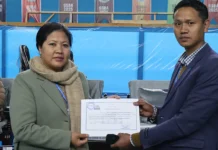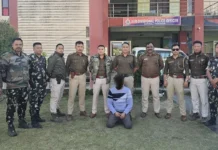Staff Reporter
ITANAGAR, 19 Dec: Chief Minister Pema Khandu on Thursday urged the people of the Siang region to give the go-ahead to conduct survey for preparing the pre-feasibility report (PFR) for the proposed 12,500 mw Siang upper multipurpose project (SUMP).
He said this in Siang HQ Boleng, addressing an event to celebrate the election victory of Rural Development & Panchayati Raj Minister Ojing Tasing.
“It is only after survey and investigation that we will know where the dam will come up, what height it will be, and how much area will be submerged,” he said.
“It takes years to clear the survey and research, and only after that can one go for the pre-feasibility report, techno-economic clearance, environmental clearance and the public hearing,” he said.
Khandu said, however, that “I still stand with the public. If people do not want dams, we won’t go ahead.”
He added that the SUMP is not just a national project and would not only affect the Adi community (Siang belt) but also the people of Assam and Bangladesh.
Elaborating his point, Khandu said that China has already approved the construction of a project that would generate a massive power of about 60,000 mw on the Yarlung Tsangpo river in Tibet, just before the river enters India through Tuting in Upper Siang district.
The CM further said that the Chinese government, which is not a signatory to the international water conventions, intends to divert the water from multiple water reservoirs to be created under the project to the dry regions of Tibet and elsewhere in the country.
“In such a scenario, it is inevitable that the volume of water in the Siang river will drastically get reduced – so much so that during winters you will be able to cross the mighty Siang on foot,” he added.
The other reason for giving the nod to the SUMP is that in case China releases water from its dams all of a sudden, “a trail of unimaginable destruction will sweep through the Siang belt,” he said.
“The SUMP has been proposed by the central government to maintain the natural flow of water in the river all year round and flood modulation in case of water release by China,” he said.
“We want to maintain good relations with China, but we should also prepare well on our part. China will surely construct dams within a decade’s time. Do you realise what the situation in the Siang region would be if it releases water?” he said.
“This is not a question of hydropower project but a question about the Adi people. We may construct dams in other parts of the state, but the issue is, how do we save the Adi people and the Siang region?” the CM said.
Khandu also questioned the silence of the Adi Bane Kebang over the issue.
Khandu said, “Adi people are known for being intellectuals, but they have missed the opportunity to have the state’s capital city in their land, and also the proposal of NEIGRIHMS (Meghalaya) has been taken away because of them. Now the dam project is more important than the two of the former projects.”
“Constructing a dam would help generations after generations. This dam project is connected with the future of the Adi community,” he said.
Khandu said, “The government is not in urgency. I am not here only for the hydropower issue but to discuss the future of Siang and the Adi people. This is a project to save the Adi, the Assamese and the people of Bangladesh.”
Urging the people to research and analyse the situation, Khandu said that the government would help in organising meetings, “no matter whichever the location.”
“The SUMP is a national project and it should be executed anyhow. Once executed, it will be of help to the people beyond one’s imagination,” he said.
Without naming individuals, he also questioned the anti-dam activists, who he said are camping in several villages.
Saying that the activists are not from the Siang region, Khandu questioned, “Where is your land here in Siang district?”
“It is the activists’ way of life to generate income out of the issue,” he said, and urged the community to “trust your own people, participate in discussions, and find a solution.”
“I can sign in writing that the Siang river will dry up one day,” he added.
It may be mentioned here that protests are ongoing in the Siang and Upper Siang regions against the proposal to deploy armed central and state police to make way for the PFR study for the Siang project.
DCM clarifies deployment of security
Meanwhile, Deputy Chief Minister Chowna Mein on Thursday asserted that the deployment of security forces in Siang and Upper Siang districts is to protect machinery and personnel involved in the survey operations for the proposed Siang multipurpose hydropower project and not to intimidate or harm residents.
Mein’s remarks came when a section of the local people opposed the project. They expressed concern over the deployment of the Central Armed Police Force (CAPF) and the potential environmental and social impact of the dam.
Addressing a public meeting at the Boleng general ground in Siang district, Mein sought to quell fears of the people protesting the survey and pre-feasibility report for the project.
“We are not anti-people, nor are we anti-Arunachal,” he said, urging the community to support the initiative.
He emphasised that the presence of the CAPF personnel in the area is just precautionary, ensuring the safety of operations.
Mein outlined the multifaceted benefits of the project, describing it as a pivotal undertaking for the development of Arunachal.
“The Siang dam is not just a project; it is an opportunity to secure the future of our youth, generate significant revenue, and bring prosperity to Arunachal,” he said.
The dam would help solve problems of water storage, irrigation, industrial supply, flood control, power generation, navigation, runoff storage, and water discharge regulation, the deputy CM said.
Clarifying discrepancies in capacity reports, Mein noted that the dam’s output is 11,000 megawatts, contrary to reports suggesting 12,500 megawatts.
He also highlighted the dam’s strategic importance in mitigating risks posed by China’s 60,000 mw dam on the Tsangpo river.
“If China releases water from their dam, the entire Pasighat town could be submerged. The Siang dam will act as a safeguard, mitigating such risks while enhancing national security,” he said.
Mein appealed to the community to consider the broader implications of the project.
“This is a step towards progress and a secure future for Arunachal,” he said, urging residents to engage in constructive dialogue.
The National Hydroelectric Power Corporation (NHPC) has proposed three sites in Upper Siang and Siang districts for the construction of the dam.
One site is between Parong and Deging villages, one at Ugeng near Riga village, and another between Ditte-Dime and Geku, officials said.
The NHPC has been conducting surveys at the proposed sites to prepare a feasibility report for the project, they said. (With PTI input)




